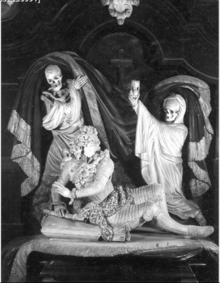Pieter Scheemaeckers
Pieter Scheemaeckers, Pieter Scheemackers, Pieter Scheemaeckers I or Pieter Scheemaeckers the Elder (alternative spellings and form of first name: Peter, Peeter and Petrus) (1640, Antwerp – 1714, Antwerp) was a Flemish sculptor who played an important role in the development of Baroque church sculpture in the Southern Netherlands.[1]
Life
His mother was the sister of the prominent Antwerp sculptor of Baroque sculpture Pieter Verbrugghen the Elder. Scheemaeckers trained with his uncle Pieter Verbrugghen the Elder.[2] He became a master of the local Guild of Saint Luke in 1674-75. In 1699 he became dean of the Guild. He received many commissions from churches in his native Antwerp, as well as from churches and abbeys in the Duchy of Brabant.
He married Catharina Verhulst. Of his many children, two sons - Pieter and Hendrik - became sculptors who made a career in England. In addition to his sons, he trained Jacob Rottiers, Inghenasius Leysens (1680–81), Joseph Verhulst, Jan van Hoeck, Abraham Hynderickx (1682–83), Jacobus Rottiers (1685-86), Peter van Tienen, Pauels de Decker (1687–88), Franciscus Sions (1688-89), Franciscus Geeregroot (1692–93), Philippus Terroude (1695–96), Judocus van Schoor, Theodor Geiregroot, Hendrick van Wetteren, Jacobus Vinckenboom (1697–98), Egidius Schoenmaeckers (1699-1700); Lenaert Batalie (1700-1701) and Jan van Rehabel (1701-1702).[2] This great number of pupils shows the respect in which he was held.[1] One of his most successful pupils was German-born Jan Pieter van Baurscheit who made a name in Antwerp as a sculptor and architect.[3]
Work

He produced mainly church sculpture and monumental tombs, in which he displayed a vivid imagination and a virtuoso execution. He also made ivory sculptures and drew many designs for other sculptors. His style is exemplary of the late Baroque in Flemish sculpture and shows the trend towards the Rococo in its pictorial and decorative effects.[1]
One of the high points of his work is the funeral monument for Count Karel Florentijn van Salm (who died at the Siege of Maastricht) in the St. Catherine Church in Hoogstraten (completed in 1709). This monument, topped by flags, military trophies and the family blazon, depicts the deceased in full battle regalia. Grieving angels, a skull and an hourglass complete the funeral monument.[4]
Selected works
- 1664: Main altar in St. Margaret Church in the Beguinage of Lier, Belgium
- 1688: Funeral monument of the family Kuerlinckx-Van Delft in the Cathedral of Antwerp
- 1692: Two side altars (one of Our Lady and the other of St. Sebastian and the Holy Cross) in the St. Willibrord Church of Berchem
- 1693: Marble communion rails of the St. Amand church in Geel
- 1693: Funeral monument for Francisco Marcos de Velasco in the St. James' Church in Antwerp (attributed to Scheemaeckers)
- 1699-1700: Altar of St. Norbert Church in Averbode Abbey
- 1707: Pulpit for the St. Martin Church in Venlo, the Netherlands
- 1709: Funerary monument for Count Karel Florentijn van Salm in the St. Catherine Church in Hoogstraten
- c. 1710: Main altar in the Our Lady of Kortenbos Basilica
References
- 1 2 3 Helena Bussers and Ingrid Roscoe. "Scheemakers: (1) Peter Scheemaeckers" Grove Art Online. Oxford Art Online. Oxford University Press. Web. 27 Mar. 2014
- 1 2 Biographical details at the Netherlands Institute for Art History (Dutch)
- ↑ Cynthia Lawrence and Frans Baudouin. "Baurscheit." Grove Art Online. Oxford Art Online. Oxford University Press. Web. 27 Mar. 2014.
- ↑ Helena Bussers, De baroksculptuur en het barok at Openbaar Kunstbezit Vlaanderen (Dutch)
External links
| Wikimedia Commons has media related to Pieter Scheemaeckers I. |